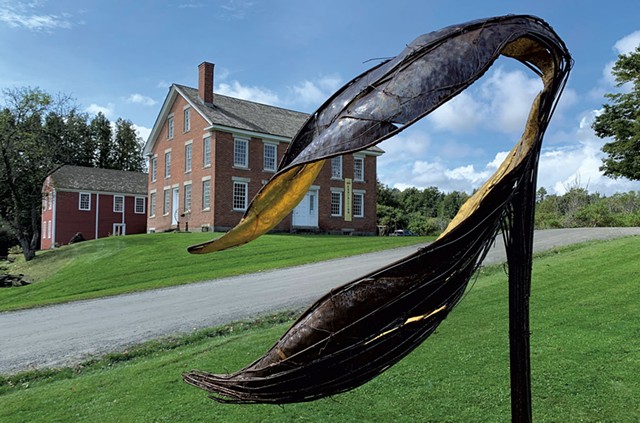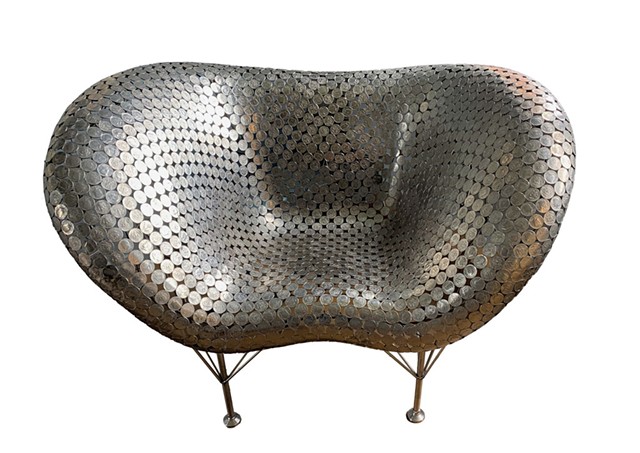
- Amy Lilly
- "Milkweed" by Sabrina Fadial with Kents' Corner State Historic Site in the background
Planning and executing the monthlong "Art at the Kent" exhibition in Calais has become a year-round project for cocurators Allyson Evans and Nel Emlen. Often with Vermont state curator David Schutz, the curators visit dozens of Vermont artists' studios every year and select a new group to show in the semi-restored 19th-century building — no one appears more than once. Then they thoughtfully place the artworks on the building's grounds and in its warren of rooms with wavy-paned windows, unique doors, fireplaces and rich arrays of unfinished wall textures.
Describing how the annual show has evolved since it began 16 years ago, Emlen joked, "It's like having kids: I had no idea it would be this time-consuming." During a recent visit, she and Evans were even busier than usual, preparing to host their first party for all the artists who'd been exhibited over the years. That number has now surpassed 260.
This year's show, called "Traces," features 23 new artists — far too many to be mentioned in this space but all worth seeing, particularly in the curators' considered arrangements of works by multiple artists in each room. Large archival-pigment prints of lichen by Brandon photographer Don Ross, for example, are paired in one room with Brattleboro kinetic sculptor Bruce Campbell's small wire butterfly with movable wings. A giant opened milkweed pod of steel and gold leaf — an outdoor sculpture by Sabrina Fadial of South Barre — can be glimpsed through the windows. The three form a trio of evanescence. Everywhere one looks in "Traces," similarly delightful groupings and views coalesce.
Emlen and Evans arrive at each show's theme organically, hashing out the feel of the chosen work with author Mary Elder Jacobsen until they collectively arrive at a verbalization. (Jacobsen coordinates Sunday readings by Vermont authors at Calais' Old West Church, a series held in tandem with the exhibition.)
The theme of "traces" reflects many of the artists' approaches, including the two whose work greets visitors in the entrance hallway.
Barre artist Athena Petra Tasiopoulos' pale paper-in-encaustic abstractions reference the memories embodied in tangible fragments such as semi-demolished buildings and Greek ruins, according to her artist's statement. And Bunny Harvey's paintings are often landscapes filled with visual traces of the sounds that permeate them. In the case of her "Listening, You See," a horizontal diptych some 11 feet wide, those sounds include breezes, birds, cows, crickets and the helicopters that regularly fly over the Tunbridge artist's studio.

- Amy Lilly
- Detail of "Listening, You See" by Bunny Harvey
Palimpsestic traces of writing cover some of the exquisitely crafted jewelry boxes by Burlington wood artist Erin Hanley. On one, a lid of black walnut is etched with equations; another of bubinga (African rosewood) is covered in hashed lines and inscrutable writing — fragments of a Richard Wilbur poem — filled with gold mica powder. In Hanley's newest venture, wall-hung works in wood, she experiments with more geometrically organized marks and lines, including the grid-like weave of "Snakey Zebra."
Worms left their own kind of palimpsestic marks on a small, untitled sculpture the curators winkingly placed on a windowsill near Hanley's boxes: a riddled slice of tree branch that Pownal's Bill Botzow augmented with ink, wax crayon and watercolor. Botzow's outdoor assembly of stick figures made from tree branches, titled "Shatterings," is visible through the window.
The Kent itself is filled with traces of its former owners and history, and the curators often exploit aesthetic or amusing coincidences between those traces and the artworks. One of Campbell's many beautifully crafted, crank-operated sculptures, titled "Game of Thrones," allows visitors to rotate four miniature crenellated towers atop a cogged brass ring. The work sits in a room covered in wallpaper samples, perfectly positioned against the sample depicting a castle scene.
Similarly, "Coquelicots," Stowe artist Marcie Scudder's extravagant dress made from circular cutouts of photos of her mother's poppies sewn together, is hung in a dramatic swirl in the Kent's ballroom.
In many rooms, the walls are exposed lath. The horizontal strips of wood complement Burlington artist Susan Smereka's "out?" — made from narrow strips of old book pages sewn together vertically; the effect is of one neutral-toned grid set against another.
West Brattleboro artist Larry Simons' nested assemblages of found wood with original paint and metal work wherever they're hung. But his vertically oriented "#93" benefits from its placement just above a door's circular metal bell. Together, the two meticulously wrought objects form an exclamation point.
Color may have influenced some of the curators' choices of placement. In the upstairs ballroom, torn turquoise wallpaper highlights archival prints by Middlebury drone photographer Caleb Kenna — one of them an aerial view of deep turquoise waters in a disused Vermont quarry.
Thetford Hill artist Ed O'Keeffe, one of three rug hookers in the show, created "Dancers," an abstract orange and blue wall hanging with rough X's in pale yellow. The work is hung on a wall whose blue wallpaper has been torn to reveal a pale yellow surface.
H. Keith Wagner's rusted metal spheres — and a large wood one, titled "Furrow," which features a crack the artist roughly stapled with bent nails — pair well with a manufactured-brick fireplace and hearth. In the nonfunctioning fireplace itself sits Wagner's acrylic painting on wood, "Winter Meadow," a near-abstract, minimalist rendering of horizon and land in muted yellow and white-dusted ecru. Wagner, a founding partner of the Burlington firm Wagner Hodgson Landscape Architecture, would likely appreciate the dialogue of materials created by the curators' placement of his work.

- Amy Lilly
- Coin chair by Johnny Swing
"Traces" is unusually interactive for an art show: There are boxes to open, cranks to turn and, in nearly every room, Johnny Swing's surprisingly comfortable chairs to sit in. The highly collectible Brookline artist has been creating his signature chairs made from coins since 1993. Their substructure alone is a wonder, but Swing's other work at the Kent reveals a broader sense of playful inventiveness. Two chairs are fashioned from rope-shaped strips of squeezed tinfoil; for another two, he screwed baby food jars to frames through their metal lids.
The Kent's invitation to visit and contemplate "Traces" is as ephemeral as its subject: The show lasts only through October 8, after which the building sits empty for 11 months, filled with nothing but, well, traces.











Comments
Comments are closed.
From 2014-2020, Seven Days allowed readers to comment on all stories posted on our website. While we've appreciated the suggestions and insights, right now Seven Days is prioritizing our core mission — producing high-quality, responsible local journalism — over moderating online debates between readers.
To criticize, correct or praise our reporting, please send us a letter to the editor or send us a tip. We’ll check it out and report the results.
Online comments may return when we have better tech tools for managing them. Thanks for reading.